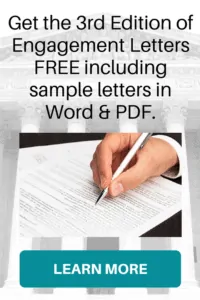Top 10 Recommendations for Planning Retirement Benefits under the SECURE Act
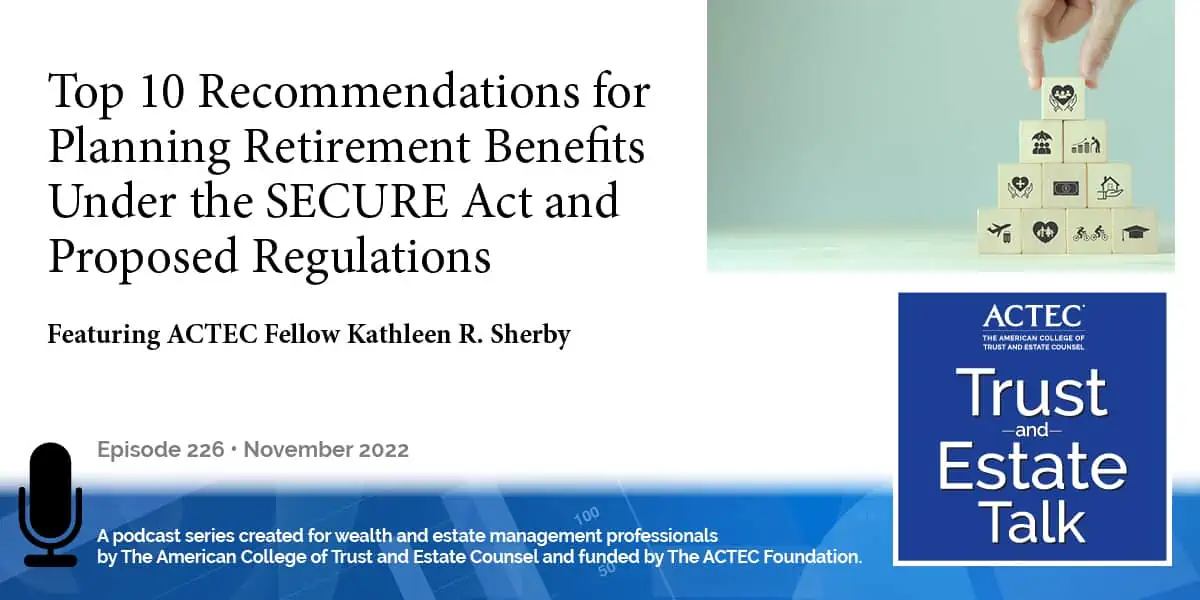
“Top 10 Recommendations for Planning Retirement Benefits under the SECURE Act and Proposed Regulations,” that’s the subject of today’s ACTEC Trust and Estate Talk.
This is Doug Stanley, ACTEC Fellow from St. Louis, Missouri. ACTEC Fellow Kathy Sherby, also from St. Louis, will share her experience and recommendations.
Hi. Planning for retirement benefits is extremely complicated, but here are my top ten recommendations to remember when you’re planning for the distribution of retirement benefits after a client’s passing away.
#1 – Beneficiary Life Expectancy
Number one – you don’t have a life expectancy for designated beneficiaries. Even though that is the case, much remains the same.
#2 – Ten-Year Distribution
Number two – you still have to comply with the “see-through” rules even to get a ten-year distribution, especially if you’re planning on doing a rollover from a qualified plan to an inherited IRA.
So, the see-through rules are that (1) the trust has to be valid and has to be irrevocable; (2) all the accountable beneficiaries have to be individuals; and (3) you have to provide certain documentation to the plan administrator by October 31st. The accountable beneficiaries being individuals is the hardest issue to deal with in dealing with and planning for a See-Through Trust. But we have a lot more rules now given to us under the proposed regulations about disregarding beneficiaries.
So, let’s start with how you plan for a married couple. If the client is married, then the spouse is still the best beneficiary outright because they can roll it over and use the Uniform Table which is about twice the length of the Single Life Table. But if it’s a second marriage, that creates some problems.
#3 – Conduit Trusts
You should consider a Conduit Trust if the client is primarily concerned about the affairs or well-being of the spouse.
#4 – Accumulation Trust
Or an Accumulation Trust if the client is more concerned about making sure that as much as possible remains for the family. You need to remember to qualify both, either one of these, for the marital deduction.
#5 – Oldest Beneficiary or Ten-Year Rule
Number five is that you no longer need to consider who the oldest beneficiary is. If there is no eligible designated beneficiary, you’ll use the ten-year rule. But if the owner is past the required beginning date, that’s going to have – the age of the designated beneficiary – which will have some impact on the distribution period because the distribution period is the longer of the designated beneficiary’s life expectancy or the decedent’s life expectancy. But it’s all limited to ten years, so it doesn’t make all that much difference.
#6 – Powers of Appointment
Number six – powers of appointment are now ignored unless they’re exercised, and trust modifications are now a useful tool because the proposed regulations now state that the service will pay attention to a modification that happens before September 30 of the year following the year of death. So, you can use a modification to qualify a See-Through Trust as a see-through trust or change accountable beneficiaries to make sure you have all individuals.
#7 – Minor Child Rule for Accumulation Trust
Number seven – use an Accumulation Trust for a minor child. You don’t have to worry about making it go outright to the minor child because the proposed regulations have a special minor child rule that allows you to disregard all of the other beneficiaries if the minor child is the sole current income beneficiary, and you get to use the minor child’s life expectancy.
#8 – Age 31 Trust for Non-Minor Child Beneficiary
Number eight – if you have a young beneficiary who is not a minor child- a niece, a nephew, that kind of beneficiary- you could use the Age 31 Trust, which requires a distribution to that young beneficiary by age 31 and you can disregard all of the other beneficiaries. You don’t get to use life expectancy, but that is not what you’re going after if you’re using the Age 31 Trust. You’re trying to disregard perhaps a charity as a beneficiary.
#9 – Applicable Multi-Beneficiary Trust
Number nine – if you have a beneficiary who possibly would be disabled or chronically ill at the client’s death, you would always want to use an Applicable Multiple Beneficiary Trust. A Tier I Applicable Multi-Beneficiary Trust, which is referred to by many as an AMBIT, would be a revocable trust that immediately divides on the death of the client into separate trusts, one of which is a separate trust solely for the benefit of the disabled or chronically ill. The benefit of using this is that all of the trusts then qualify for the separate account rule, which is a really big benefit. The Tier II AMBIT is the trust that would be solely for the benefit of the disabled or chronically ill beneficiary for their lifetime.
#10 – Benefits or Accumulation over Conduit See-Through Trust
And number ten – if the beneficiaries of the trust are not ADBs, a plain-old designated beneficiary, then you should use an Accumulation See-Through Trust and not a Conduit See-Through Trust. Since you’re not going to get to use their life expectancies anyway, the only time you would use a Conduit See-Through Trust is if you were trying to disregard a charity that was the remainder beneficiary.
Those are my top 10 most important things to remember in planning for retirement benefits.
Thank you, Kathy, for sharing with us your knowledge on this very complicated topic.
You may also be interested in:
- The SECURE Act and Retirement Account Planning Opportunities
- Updating Existing Estate Plans Under the SECURE Act (SECURE Act Special – Part 1 of 5)
- Planning for Common Scenarios Under the SECURE Act (SECURE Act Special – Part 2 of 5)
- Designing and Drafting Trusts in Light of the SECURE Act (SECURE Act Special – Part 3 of 5)
- Disabled or Chronically Ill Beneficiaries Under the SECURE Act (SECURE Act Special – Part 4 of 5)
- Trusts for Disabled and Chronically Ill Beneficiaries under the SECURE Act
This podcast was produced by The American College of Trust and Estate Counsel, ACTEC. Listeners, including professionals, should under no circumstances rely upon this information as a substitute for their own research or for obtaining specific legal or tax advice from their own counsel. The material in this podcast is for information purposes only and is not intended to and should not be treated as legal advice or tax advice. The views expressed are those of speakers as of the date noted and not necessarily those of ACTEC or any speaker’s employer or firm. The information, opinions, and recommendations presented in this Podcast are for general information only and any reliance on the information provided in this Podcast is done at your own risk. The entire contents and design of this Podcast, are the property of ACTEC, or used by ACTEC with permission, and are protected under U.S. and international copyright and trademark laws. Except as otherwise provided herein, users of this Podcast may save and use information contained in the Podcast only for personal or other non-commercial, educational purposes. No other use, including, without limitation, reproduction, retransmission or editing, of this Podcast may be made without the prior written permission of The American College of Trust and Estate Counsel.
If you have ideas for a future ACTEC Trust & Estate Talk topic, please contact us at ACTECpodcast@ACTEC.org.
© 2018 – 2024 The American College of Trust and Estate Counsel. All rights reserved.
Latest ACTEC Trust and Estate Talk Podcasts
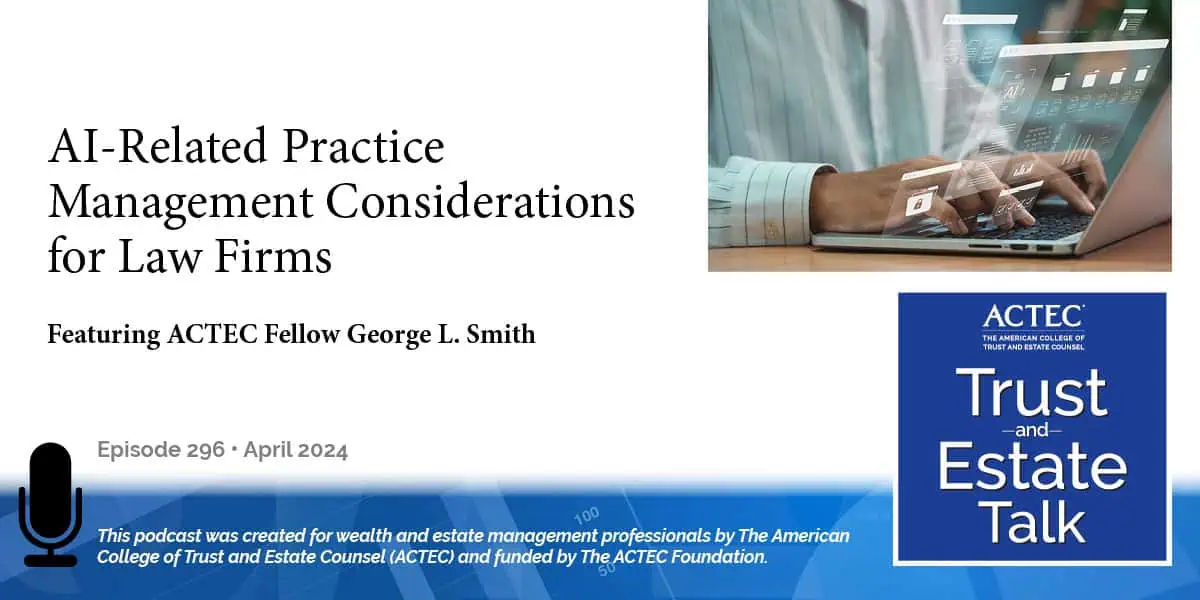
AI-Related Practice Management Considerations for Law Firms
A discussion for law firms about how to incorporate AI in their practice management, including staff considerations, the “billable hour,” and more.
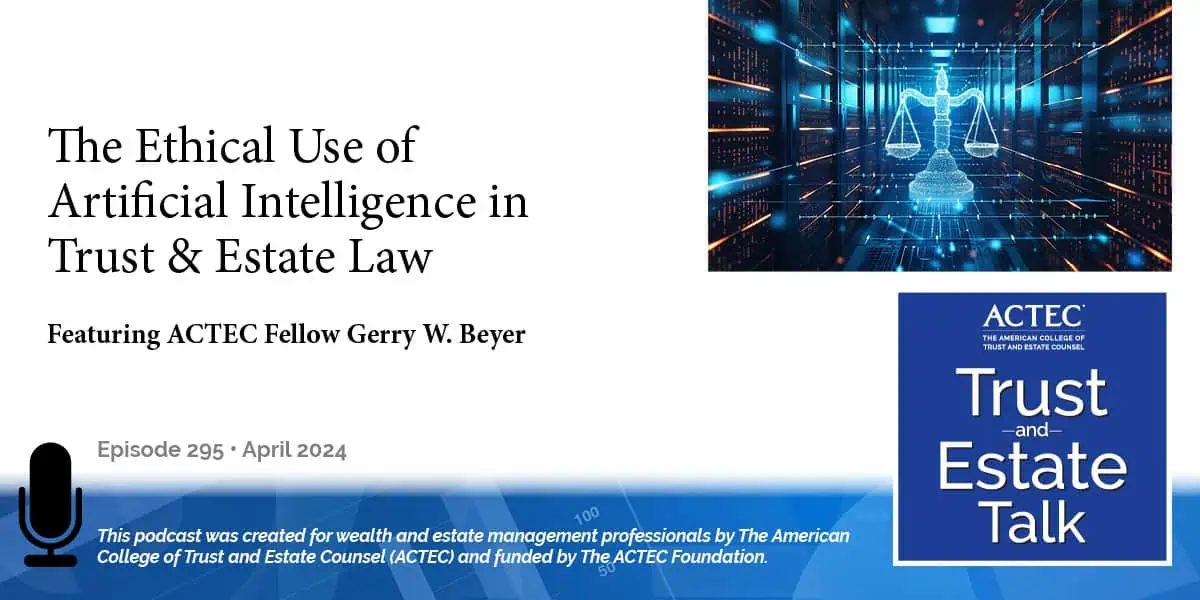
The Ethical Use of Artificial Intelligence in Trust & Estate Law
A law professor offers insights into the risks, rewards, duties and ethical considerations of lawyers using AI in their T&E practices.
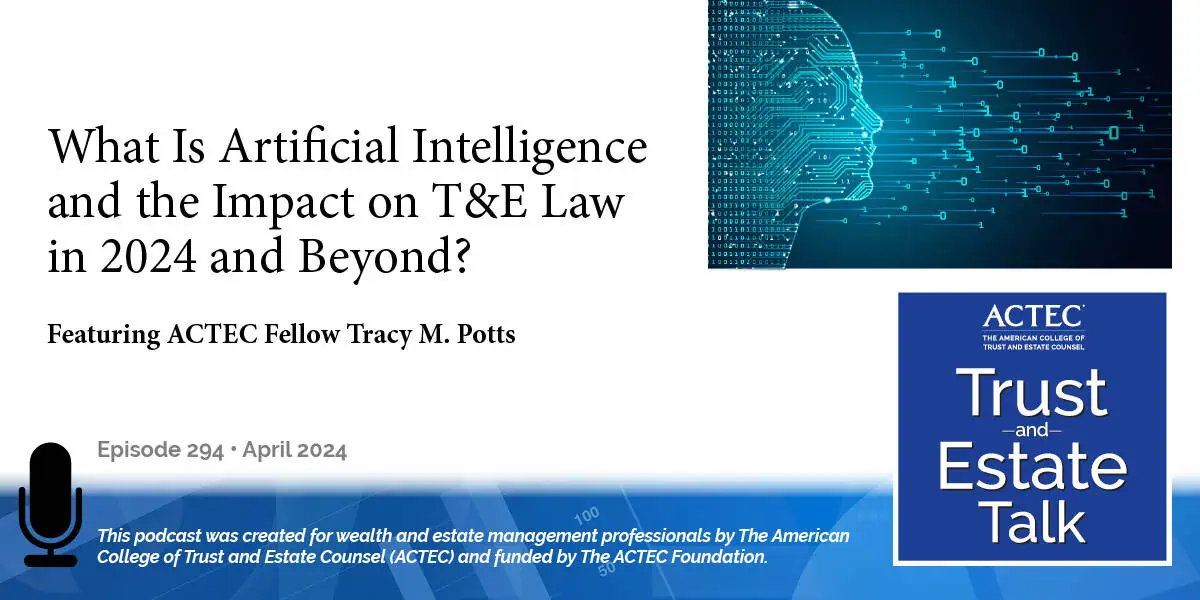
What Is Artificial Intelligence and the Impact on T&E Law in 2024 and Beyond?
A primer on the types and uses of AI, then a deeper dive into the impact on trust and estate law from types to applications to ethical considerations.

